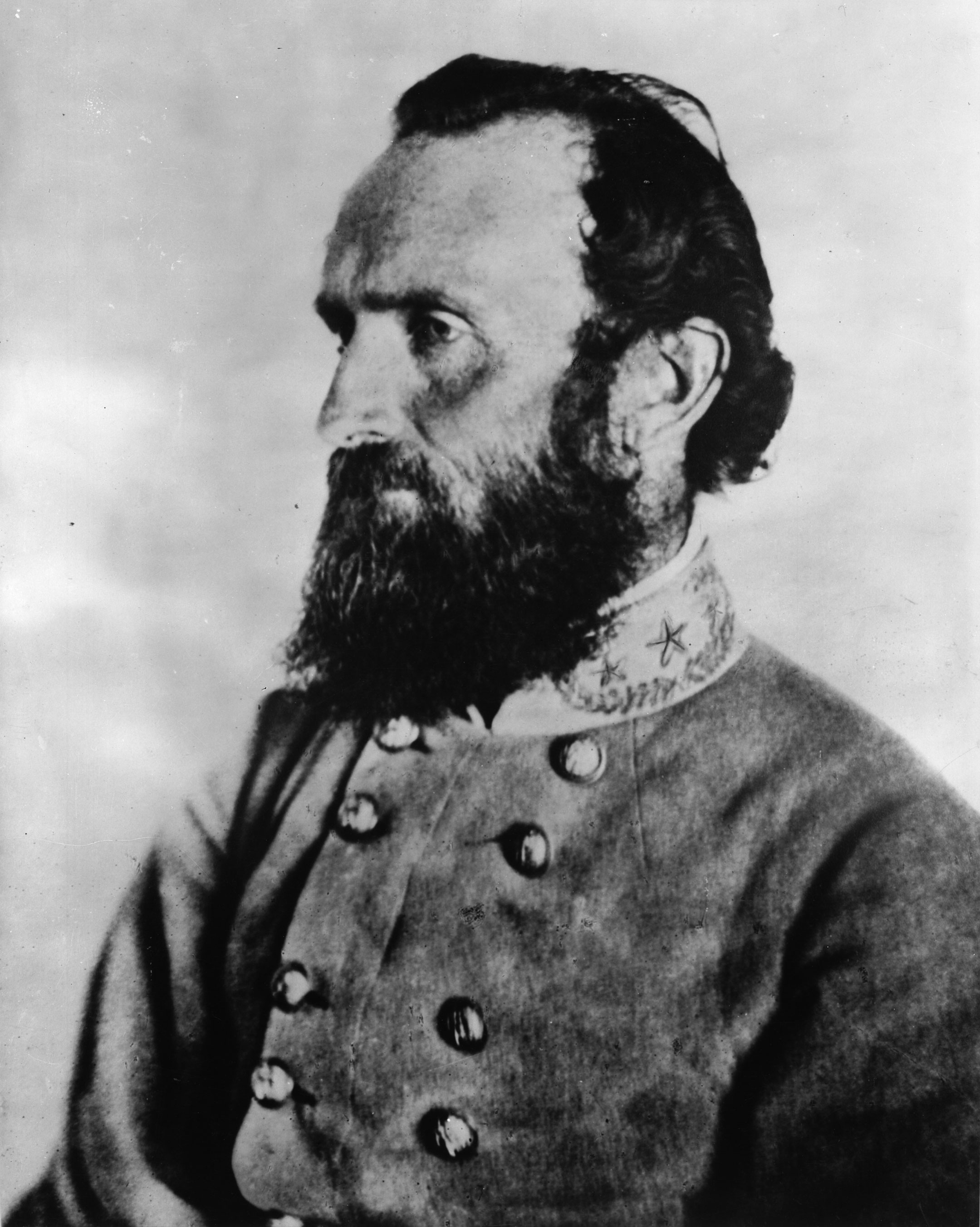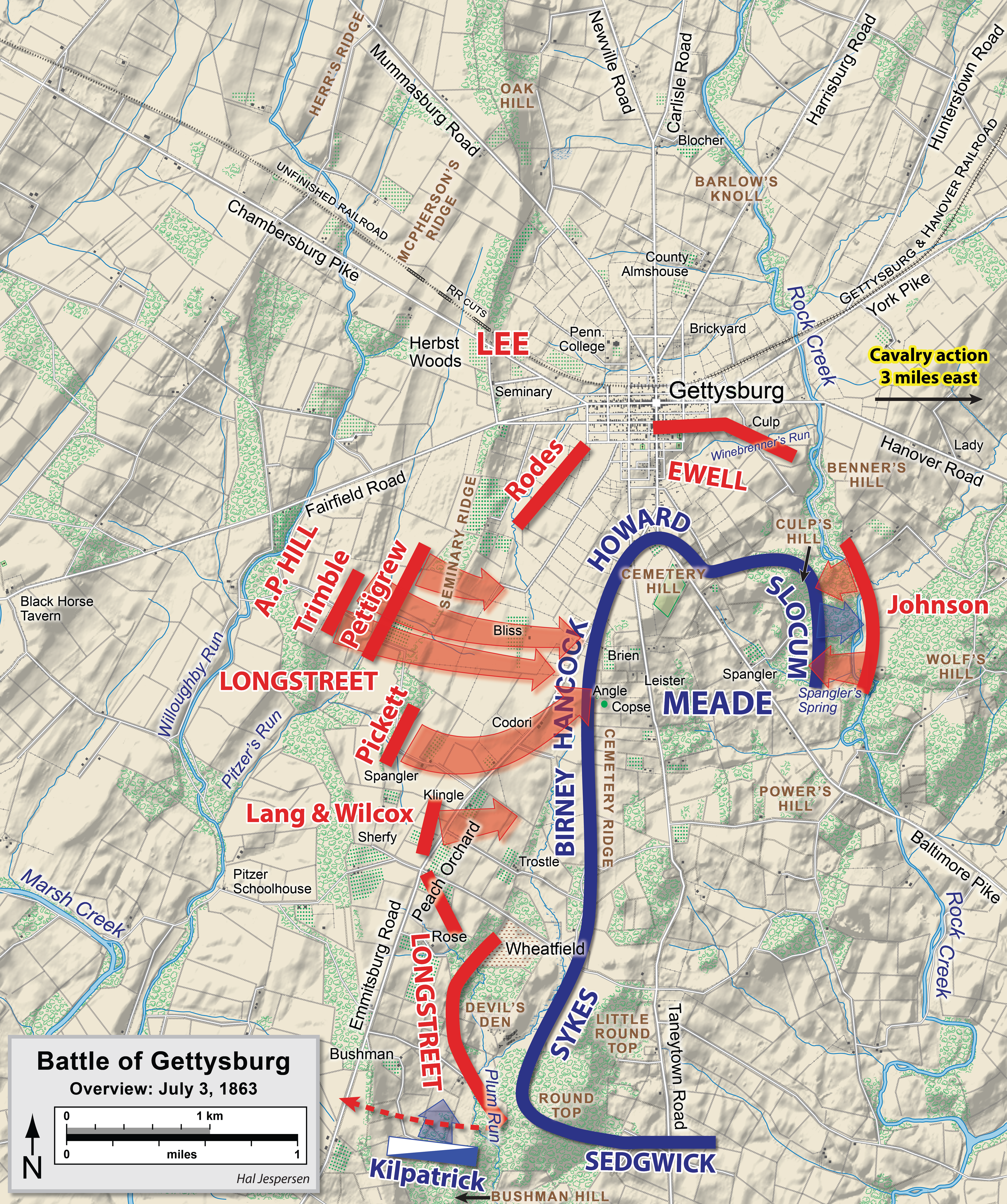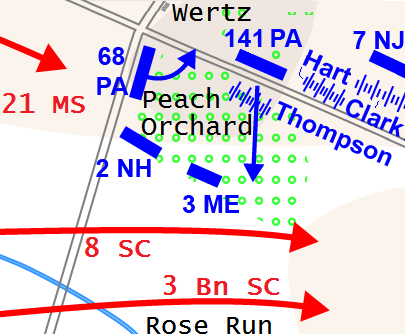|
McLaws' Assault
During the second day of the Battle of Gettysburg (July 2, 1863) Confederate Gen. Robert E. Lee attempted to capitalize on his first day's accomplishments. His Army of Northern Virginia launched multiple attacks on the flanks of the Union Army of the Potomac, commanded by Maj. Gen. George G. Meade. The assaults were unsuccessful, and resulted in heavy casualties for both sides. Early in the afternoon, Union Maj. Gen. Daniel Sickles repositioned his III Corps forward in a salient without authorization in the hopes of occupying slightly elevated ground to his front. After a short delay to assemble his forces and avoid detection in his approach march, Lt. Gen. James Longstreet attacked with his First Corps against the Union left flank. His division under Maj. Gen. John Bell Hood attacked Little Round Top and Devil's Den. To Hood's left, Maj. Gen. Lafayette McLaws attacked the Wheatfield and the Peach Orchard. Although neither prevailed, the Union III Corps was effectively ... [...More Info...] [...Related Items...] OR: [Wikipedia] [Google] [Baidu] |
Gettysburg Battle Map Day2
Gettysburg may refer to: Events * Gettysburg Campaign, a series of American Civil War military engagements in the Main Eastern Theater. ** Battle of Gettysburg, July 1–3 military engagements during the 1863 Gettysburg Campaign ** Retreat from Gettysburg, the Confederate and Union armies' return to the South following the Battle of Gettysburg * Gettysburg Address, President Abraham Lincoln's speech at the November 19, 1863, Consecration of the National Cemetery at Gettysburg. Places ; Pennsylvania-related articles *Gettysburg, Pennsylvania ** Gettysburg Battlefield Historic District, of historic properties, buildings, and structures in Adams County, Pennsylvania ** Gettysburg National Military Park, protected by the National Park Service *** Gettysburg Museum and Visitor Center, the National Park Service's reception center *** Gettysburg National Cemetery, a district of the military park on Cemetery Hill *** Gettysburg National Museum, the 1921 museum used as the 1974-2008 NPS v ... [...More Info...] [...Related Items...] OR: [Wikipedia] [Google] [Baidu] |
John Bell Hood
John Bell Hood (June 1 or June 29, 1831 – August 30, 1879) was a Confederate general during the American Civil War. Hood's impetuosity led to high losses among his troops as he moved up in rank. Bruce Catton wrote that "the decision to replace Johnston with Hood was probably the single largest mistake that either government made during the war." Hood's education at the United States Military Academy led to a career as a junior officer in the infantry and cavalry of the antebellum U.S. Army in California and Texas. At the start of the Civil War, he offered his services to his adopted state of Texas. He achieved his reputation for aggressive leadership as a brigade commander in the army of Robert E. Lee during the Seven Days Battles in 1862, after which he was promoted to division command. He led a division under James Longstreet in the campaigns of 1862–63. At the Battle of Gettysburg, he was severely wounded, rendering his left arm mostly useless for the rest of his life. Tra ... [...More Info...] [...Related Items...] OR: [Wikipedia] [Google] [Baidu] |
I Corps (Union Army)
I Corps (First Corps) was the designation of three different corps-sized units in the Union Army during the American Civil War. Separate formation called the I Corps served in the Army of the Ohio/ Army of the Cumberland under Alexander M. McCook from September 29, 1862 to November 5, 1862, in the Army of the Mississippi under George W. Morgan from January 4, 1863 to January 12, 1863 (which was the re-designated XIII Corps (ACW)), and in the Army of the Potomac and Army of Virginia (see below). The first two were units of very limited life; the third was one of the most distinguished and veteran corps in the entire Union Army, commanded by very distinguished officers. The term "First Corps" is also used to describe the First Veteran Corps from 1864 to 1866. History The I Corps was created on March 3, 1862, when President Abraham Lincoln ordered the creation of a five-corps army, then under the command of Major General George B. McClellan. The first commander of the cor ... [...More Info...] [...Related Items...] OR: [Wikipedia] [Google] [Baidu] |
Cemetery Hill
Cemetery Hill is a landform on the Gettysburg Battlefield that was the scene of fighting each day of the Battle of Gettysburg (July 1–3, 1863). The northernmost part of the Army of the Potomac defensive " fish-hook" line, the hill is gently sloped and provided a site for American Civil War artillery (cf. the heavily wooded, adjacent Culp's Hill). Plan Cemetery Hill overlooks the main downtown area of Gettysburg from the south, at above sea level, above the town center, about above Winebrenner's Run at its base. Its crest extends in a southwest–northeast direction for about . A shallow saddle on the crest about from its northeast slope is the point where the Baltimore Pike crosses the hill and separates East Cemetery Hill from the remainder. The slopes to the north and west rise gradually; on East Cemetery Hill, the rise is steeper. The hill is crossed by the Baltimore Pike and the Emmitsburg Road, with the Taneytown Road between them. History The 1858 south bou ... [...More Info...] [...Related Items...] OR: [Wikipedia] [Google] [Baidu] |
Culp's Hill
Culp's Hill,. The modern U.S. Geographic Names System refers to "Culps Hill". which is about south of the center of Gettysburg, Pennsylvania, played a prominent role in the Battle of Gettysburg. It consists of two rounded peaks, separated by a narrow saddle. Its heavily wooded higher peak is above sea level. The lower peak is about 100 feet (30 m) shorter than its companion. The eastern slope descends to Rock Creek (Monocacy River), Rock Creek, about 160 feet (50 m) lower in elevation, and the western slope is to a saddle with Stevens Knoll (formerly McKnight's Hill) with a summit lower than the main Culp's Hill summit. The hill was owned in 1863 by farmer Henry Culp and was publicized as "Culp's Hill" by October 31, 1865. During the Battle of Gettysburg, July 1–3, 1863, Culp's Hill was a critical part of the Union Army defensive line, the principal feature of the right flank, or "barbed" portion of what is described as the "fish-hook" line. Holding the hill was by i ... [...More Info...] [...Related Items...] OR: [Wikipedia] [Google] [Baidu] |
Demonstration (military)
In military terminology, a demonstration is an attack or show of force on a front where a decision is not sought, made with the aim of deceiving the enemy. An example of a demonstration in the American Civil War was at the Battle of Gettysburg where, on July 2, 1863, General Robert E. Lee ordered Lieutenant General Richard S. Ewell to stage a demonstration against Culp's Hill on the Union right flank while Lieutenant General James Longstreet James Longstreet (January 8, 1821January 2, 1904) was a General officers in the Confederate States Army, Confederate general during the American Civil War and was the principal subordinate to General Robert E. Lee, who called him his "Old War Ho ... launched the main attack against the Union left flank. A related diversionary maneuver, the feint, involves actual contact with the enemy, unlike a demonstration. See also * Feint References {{mil-stub Demonstration Military deception Military deployment ... [...More Info...] [...Related Items...] OR: [Wikipedia] [Google] [Baidu] |
Richard S
Richard is a male given name. It originates, via Old French, from Old Frankish and is a compound of the words descending from Proto-Germanic language">Proto-Germanic ''*rīk-'' 'ruler, leader, king' and ''*hardu-'' 'strong, brave, hardy', and it therefore means 'strong in rule'. Nicknames include " Richie", " Dick", " Dickon", " Dickie", " Rich", " Rick", "Rico (name), Rico", " Ricky", and more. Richard is a common English (the name was introduced into England by the Normans), German and French male name. It's also used in many more languages, particularly Germanic, such as Norwegian, Danish, Swedish, Icelandic, and Dutch, as well as other languages including Irish, Scottish, Welsh and Finnish. Richard is cognate with variants of the name in other European languages, such as the Swedish "Rickard", the Portuguese and Spanish "Ricardo" and the Italian "Riccardo" (see comprehensive variant list below). People named Richard Multiple people with the same name * Richard Ander ... [...More Info...] [...Related Items...] OR: [Wikipedia] [Google] [Baidu] |
Second Corps, Army Of Northern Virginia
The Second Corps of the Army of Northern Virginia was a military organization within the Confederate States Army, Confederate Army of Northern Virginia during much of the American Civil War. It was officially created and named following the Battle of Sharpsburg in 1862, but comprised units in a corps organization for quite some time prior to that. The Second Corps developed a reputation for hard fighting under famed early commander Stonewall Jackson, Thomas J. "Stonewall" Jackson. Background The troops comprising the Second Corps originally were known as the Second Corps of the Army of the Potomac (Confederate), Army of the Potomac, under the command of Major general (United States), Major General Gustavus W. Smith. This unit was also known as the Second Division and was eventually subsumed into General officer, General Robert E. Lee's Army of Northern Virginia as a reserve in Maj. Gen. D. H. Hill's Division. When Lee was able to reorganize his army after finishing battles with Un ... [...More Info...] [...Related Items...] OR: [Wikipedia] [Google] [Baidu] |
Cemetery Ridge
Cemetery Ridge is a geographic feature in Gettysburg National Military Park, south of the town of Gettysburg, Pennsylvania, that figured prominently in the Battle of Gettysburg, July 1 to July 3, 1863. It formed a primary defensive position for the Union Army during the battle, roughly the center of what is popularly known as the "fish-hook" line. The Confederate States Army launched attacks on the Union positions on the second and third days of the battle, but were driven back both times. Description The ridge rises only about above the surrounding terrain and is under long. The northern end rises to become Cemetery Hill, the southern descends to low, wooded, and sometimes marshy ground just north of Little Round Top. At the northern end of Cemetery Ridge is a copse of trees and a low stone wall that makes two 90-degree turns; the latter has been nicknamed '' The Angle'' and is also referred to as ''the High Water Mark of the Confederacy''. This area, and the nearby Codori F ... [...More Info...] [...Related Items...] OR: [Wikipedia] [Google] [Baidu] |
Richard H
Richard is a male given name. It originates, via Old French, from Old Frankish and is a compound of the words descending from Proto-Germanic language">Proto-Germanic ''*rīk-'' 'ruler, leader, king' and ''*hardu-'' 'strong, brave, hardy', and it therefore means 'strong in rule'. Nicknames include " Richie", " Dick", " Dickon", " Dickie", " Rich", " Rick", "Rico (name), Rico", " Ricky", and more. Richard is a common English (the name was introduced into England by the Normans), German and French male name. It's also used in many more languages, particularly Germanic, such as Norwegian, Danish, Swedish, Icelandic, and Dutch, as well as other languages including Irish, Scottish, Welsh and Finnish. Richard is cognate with variants of the name in other European languages, such as the Swedish "Rickard", the Portuguese and Spanish "Ricardo" and the Italian "Riccardo" (see comprehensive variant list below). People named Richard Multiple people with the same name * Richard Ander ... [...More Info...] [...Related Items...] OR: [Wikipedia] [Google] [Baidu] |
Third Corps, Army Of Northern Virginia
Third or 3rd may refer to: Numbers * 3rd, the ordinal form of the cardinal number 3 * , a fraction of one third * 1⁄60 of a ''second'', i.e., the third in a series of fractional parts in a sexagesimal number system Places * 3rd Street (other) * Third Avenue (other) * Highway 3 Music Music theory * Interval number of three in a musical interval **Major third, a third spanning four semitones **Minor third, a third encompassing three half steps, or semitones ** Neutral third, wider than a minor third but narrower than a major third ** Augmented third, an interval of five semitones ** Diminished third, produced by narrowing a minor third by a chromatic semitone * Third (chord), chord member a third above the root * Degree (music), three away from tonic ** Mediant, third degree of the diatonic scale **Submediant, sixth degree of the diatonic scale – three steps below the tonic ** Chromatic mediant, chromatic relationship by thirds *Ladder of thirds, simila ... [...More Info...] [...Related Items...] OR: [Wikipedia] [Google] [Baidu] |
The Peach Orchard
The Peach Orchard is a Gettysburg Battlefield site at the southeast corner of the north-south Emmitsburg Road intersection with the Wheatfield Road. The orchard is demarcated on the east and south by Birney Avenue, which provides access to various memorials regarding the "momentous attacks and counterattacks in…the orchard on the afternoon of July 2, 1863." Geography The Peach Orchard is on a hornfel along the northwest edge of the local geologic diabase sheet and at the "angle of the Peach Orchard" formed by the vertex of 2 low ridges: "one from Devil's Den, the other along the Emmitsburg road." The orchard drains southward into Rose Run, through Rose Woods, to Plum Run; and the orchard tract has a modern north-south embankment along the Emmitsburg road to the west of which a drainage depression separates the orchard from Warfield Ridge. History By 1858 on the southeast corner of the crossroads, the Peach Orchard had been planted by Reverend Joseph Sherfy, who had a hom ... [...More Info...] [...Related Items...] OR: [Wikipedia] [Google] [Baidu] |







